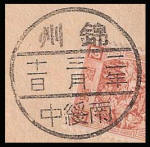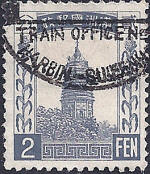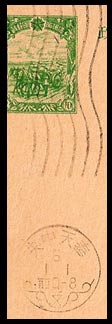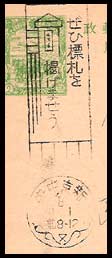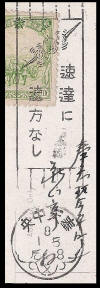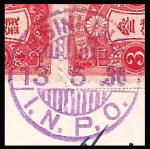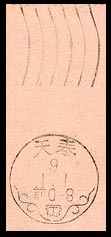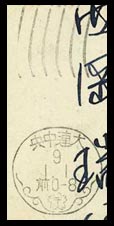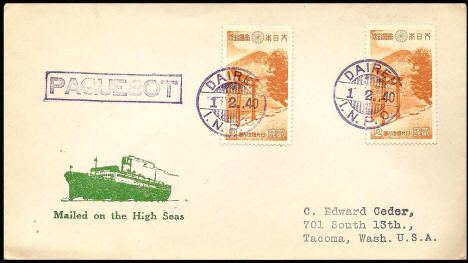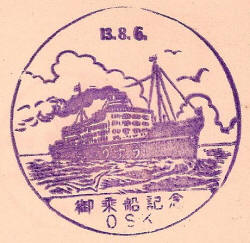 |
||||||||
|
|
Understanding Manchukuo Postmarks and Cancels This is an attempt at explaining a little about the postmarks or Manchukuo based upon the limited amount of material in this collection. A certain amount of caution is needed because this section may contain some errors. If you are interested in the postmarks of Manchukuo I recommend that you find the following books. Manchuria in Transition 1925 - 1934 by Dr Robert W. Farquhar's this features colour images of a large number of early cancels, and much else. The Philatelic Gazetteer of Manchukuo and Kwantung Leased Territory South Manchurian Railway Zone by George A Fisher jr. This gives examples of the Kanji postal names used in the cancels so it is an essential guide and a great help in identifying towns of origin. I have used it extensively to check the characters used on the website. Japanese Post Offices in China and Manchuria by John Mosher. This specializes in the cancels used by Japanese post offices and also gives a history of many post offices, together with other information of interest to the collector. I have also found Google Translate and a website http://www.nciku.com helpful. When all else fails you can use nciku.com to draw the characters you are looking for and Google Translate to provide the Romanisation.
Dates used for Postmarks and Cancels Whenever you see used stamps from Manchukuo being advertised the seller nearly always dates the stamp incorrectly by misreading the date on the postmark. This is because both in Manchukuo and Japan the year date is based upon the era of the reign of the current Emperor. The Chinese sequence is usually - Year : Month : Day - if Arabic numerals are used or - Day : Month : Year - if the date is shown in characters. Needless to say there are exceptions to the above. Postmarks on overseas mail from major towns such as Mukden (Moukden) and Harbin use Western dating, the appearance of this varies. Numbers in brackets indicate the time and the number next to this is normally the year. Hence (8) 1.12.2 would be (8am) 1932 December 2nd and 1.12.2 (8) would be 1st December 1933 (8am) but even this is inconsistent. This format only appears in early, larger diameter postmarks from the big cities such as Harbin. The first era in Manchukuo started from the Founding of the state in 1932, this era was named Datong (大同) or in Japanese Daido, The second era starts from Enthronement of Puyi as the Emperor Kang-teh on 1st March 1934 and was named Kangde (康德) "Tranquillity and Virtue" in Japanese Kotoku. Both eras started with a year date 1. In Japan, (and Japanese postmarks often appear on covers from Manchukuo), the era name is Shōwa starting from the time of the enthronement of the Emperor Hirohito in 1926. In this case 1932 is year seven and 1945 is year twenty. Chinese transit postmarks also appear on stamps and covers from Manchukuo and these start from the date of the founding of the Republic in 1911 making the year date for 1932, 21. In the West we use the Gregorian Calendar. This is based upon the notional birth date of Christ being year one. This is now the internationally accepted civil calendar. Even this is expressed in different ways, the English system is most often used for postmarks - Day : Month : Year - the Americans use - Month : Day : Year. It pays to look carefully at all postmarks and to check the dates. The table below might help.
|
|||||||
| Western Year No. | Manchukuo Year Number (大同 Datong) | Japanese Year Number (昭和 Shōwa) |
Chinese Year Number |
|||||
| 1932 一九三二 | 1 一 | 7 七 | 21 廿 一 | |||||
| 1933 一九三三 | 2 二 | 8 八 | 22 廿二 | |||||
| 1934 一九三四 (This new era from 1st March was called 康德 Kāngdé) |
Prior to 1st March
"3"
三 1st March onwards "1" 一 Sometimes "元" is used. |
9 九 | 23 廿三 | |||||
| 1935 一九三五 | 2 二 | 10 十 | 24 廿四 | |||||
| 1936 一九三六 | 3 三 | 11 十一 | 25 廿五 | |||||
| 1937 一九三七 | 4 四 | 12 十二 | 26 廿六 | |||||
| 1938 一九三八 | 5 五 | 13 十三 | 27 廿七 | |||||
| 1939 一九三九 | 6 六 | 14 十四 | 28 廿八 | |||||
| 1940 一九四十 | 7 七 | 15 十五 | 29 廿九 | |||||
| 1941 一九四一 | 8 八 | 16 十六 | 30 卅 | |||||
| 1942 一九四二 | 9 九 | 17 十七 | 31 卅 一 | |||||
| 1943 一九四三 | 10 十 | 18 十八 | 32 卅二 | |||||
| 1944 一九四四 | 11 十一 | 19 十九 | 33 卅三 | |||||
| 1945 一九四五 | 12 十二 | 20 廿 | 34 卅四 | |||||
|
Some Chinese Style (Native) Examples The early postmarks of Manchukuo fall into three main types, Chinese, Bilingual and Roman. |
||||||||
|
|
|
|
|
|||||
|
This is a typical Chinese style cancel 30mm diameter in black. Black ink was used for cancels made with a metal stamp and deep violet for a rubber stamp. This type of cancel served for domestic use, they were phased out during 1936 and replaced by Japanese style "comb" cancels. The cancel is divided into three parts (tri-sected) with the province at the top, the date in the middle and the postal town at the base. In this instance 錦州 Chin Chou (Jinzhou) is shown as the province, a date of (十一) 11th, (三) March, (二) 1935. The post office is 南綏中 Nan-Sui-Chung, please note that the names read from right to left. Clicking on the link you will see that it takes you to a 1945 map of Manchuria. Note; My understanding is that Nansuichung (South Suichung) was the name of a PO in Shanhaikwan, Chin Chow was later renamed Chin Hsien. |
||||||||
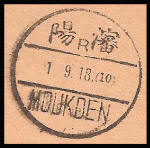 |
This is an early 30mm diameter bi-lingual international mail postmark from Moukden in black. This may appear as a cancel or a transit mark. Mukden is the Manchu name for Shenyang 瀋陽, which is how it appears in the top section of the postmark reading right to left. (Later Shenyang was replaced with Fengtian 奉天 the postal district). The small "R" is used to identify the post office, The date also reads from right to left (10) represents the hour the cancel was applied 10am, then 13th September 1932. The town name clearly appears in the bottom panel. |
|||||||
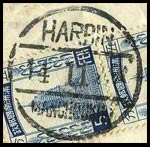 |
This is an early 30mm diameter international mail postmark from Harbin in black, these sometimes occur in blue/purple. All is in Western lettering. The town name "Harbin" appear in in the top segment. The date 14th November 1934 is shown in the centre and the country name "Manchoukuo" is shown in the bottom segment. Note; There was no U.P.U. obligation to use western lettering on international mail, but quite sensibly Japan adopted this practice from the early 1900's. This did not mean that the odd cover did not travel under a domestic postmark by mistake. |
|||||||
|
This is an early Harbin Train Office postmark 30mm diameter. In this instance the line was HARBIN-SUIFENHO. Sui-fen-ho (綏芬河) was the last stop in Manchukuo on the railway to the Russian port of Vladivostok (Владивосток). The Train Office number would have been 1, 2, 3 or 4. The top segment of this cancel shows the same information in Chinese and the central section shows the date and time. Other lines with a similar cancel are HARBIN-CHANGCHUN or HARBIN-MANCHULI. Other postmarks known are KIRIN-CHANGCHUN and HULAN-HAILUN. These postmarks are rare and sought after by collectors. |
||||||||
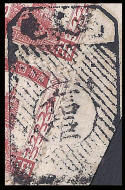 |
This is an undated letterbox postmark,
these are very rare and few have been discovered associated with Manchukuo.
The town name is hard to read and my best guess is 范家屯
Fan-chia-t’un
near Hsinking. The two characters in the circle literally read 信柜
Letter Box. See a better image
here. These cancels measure 23mm x 36.5mm and are likely to be from villages too small to be served by a postal agent. The theory is that the postman would apply the cancel when he emptied the mail-box. Manchuria in Transition 1925 - 1934 Dr Robert W. Farquhar illustrates another of these postmarks associated with 甘旗卡 Kan-Ch'i-K'a in Hsing Nan. The number of these postmarks is unknown and other villages may also be represented. |
|||||||
|
|
||||||||
|
Some Japanese Style (Comb) Examples |
||||||||
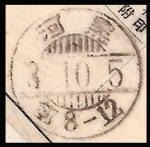 |
This is the standard Japanese comb style cancel used from 1936 onwards. The majority of cancels from both Manchukuo and Japanese offices within Manchukuo take this form. Almost all are black with a 23mm to 25mm diameter (normally referred to as 25mm Japanese comb style cancels). The name of the town is shown in the top section in this instance 黑河 Hei ho (Heihe), the characters read right to left. The central date section, also right to left reads 5th October 1936.
At the bottom is
the cancel time indicates the time the cancel was applied. This is
signified by the use of 前 meaning "before" or a.m,
before noon, normally 8-12 as here, 后 or |
|||||||
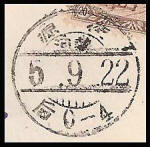 |
This is a variation on the standard 25mm diameter Japanese comb style cancel. In this instance the province name 熱河 Jehol replaces the upper comb, the characters read right to left. The name of the town is shown in the top section in this instance 凌源 Lingyuan, the characters read right to left. The central date section, also right to left reads 22nd September 1938. At the bottom is the cancel time 后 0-4 p.m. |
|||||||
 |
Japanese style comb cancel 25mm diameter in black. This type of cancel was used only for international mail although examples also exist on philatelic covers sold by dealers. International cancels such as this did not exist for all post offices so these also appear as transit postmarks. In this case the town name "Harbin" appears at the top. The central dater reads 19th September 1940, the bottom panel reads "Manchoukuo". |
|||||||
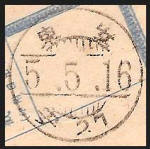 |
This is a variation on the standard 25mm diameter Japanese comb style cancel in black with two comb sections. This cancel comes from a telegraph money transfer from office 27 in Antung. You can see this here. The name of the town is shown in the top section 安東 Antung, the characters read right to left. The central date section, also right to left, reads 16th May 1938. At the bottom of the cancel is the office number "27". |
|||||||
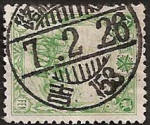 |
This is a money order date stamp based on the standard 25mm diameter Japanese comb style cancel in black with two comb sections. The post office is unreadable. The cancel is dated 26th February 1940, reading right to left. At the base of the cancel is 吉 153. All civilian money order date stamps used this form of office code, the character 吉 chi being short for Kirin. Other offices follow a similar format including 奉 feng for Fengtian, 濱 pin Harbin and 間 chien for Chien-tao. For more information on money order date stamps see an article by Robert M Spalding entitled Manchukuo M.O.P.S. Cancels which appears in Vol 52: No 1 of Japanese Philately Feb 97. |
|||||||
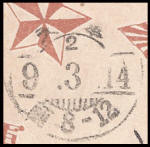 |
This is a Japanese Military date stamp based on the standard 25mm diameter Japanese comb style cancel in black with two comb sections. These were used in Manchukuo between 1931 and 1936. They normally appear on free 軍事郵便 (Gunji Yūbin) Japanese Military Mail, cards and letters. During this period all Military mail travelled through SMRZ branches at Hsinking, Mukden or Szepingkai. Later mail was handled entirely within the military and the need for a postmark disappeared. The cancel is dated 14th March 1935, reading right to left. It is important to know that the dating is based on the Japanese 昭和 Shōwa year date, possibly uniquely in for a Postmark used in Manchukuo. The top segment shows the characters for 奉 天 Fengtian (Mukden) and below this is the number "2" it is this that signifies that it is a military cancel. |
|||||||
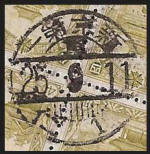 . |
This is a military money order date stamp, again using the standard 25mm diameter Japanese comb style cancel in black with two comb sections. The post office reads 新京第一 meaning First Hsinking, in place of the top comb is 軍 army (appropriately pronounced "gun" in Japanese). The cancel is dated 25th September 1944, reading left to right. At the base of the cancel is 仁 1. At the bottom of all military money order date stamps was an ideograph representing one of the five Confusion cardinal virtues, in this instance 仁 stands for Benevolence, followed by the office number 1. The other four ideographs used were 義 Justice, 禮 Decorum, 智 Wisdom and 信 Honesty |
|||||||
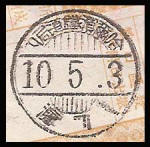 |
This
example is a money order date stamp supplied by a railway bureau.
This used the 25mm diameter Japanese comb style cancel in black with
two comb sections. In this instance the top line reads 哈爾濱鐵道局内 鐵道 Tetsudō/ Railway (or railroad) 局 kyoku/ bureau 内 (nai/inside) means inside Harupin Tetsudōkyokunai Harbin Railway Bureau. Character at the bottom is 满 for Harbin with an office number of 71. |
|||||||
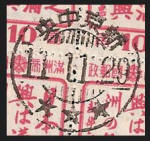 |
This is a another variation on the standard 25mm diameter Japanese comb style cancel. In this instance the post office is the familiar 新京中央 Hsinking central post office. The date shown is 29th November 1944 and below this are three stars. Stars are used to indicate that a stamp is being cancelled by a post office for a non-postal use. They appear most commonly when stamps are cancelled to order. Similar stars also appear on railway cancels associated with the Kwantung Leased Territory. The stars have nothing to do with the Communist or Nationalist regimes. |
|||||||
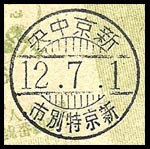 |
This is a
yet another variation on the standard 25mm diameter Japanese comb
style cancel. Like the example shown above it is also from
新京中央
Hsinking central post office.
The date shown is 1st July 1945. In this instance, in place of the time we have five characters which read 新京特别市 Hsinking Special City". This may also have been used for "cancel to order" purposes where the time would have no useful function. |
|||||||
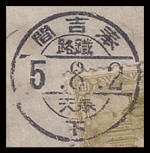 |
This is the railway version of the standard 25mm diameter Japanese comb
style cancel. In this example the The cancel is from the
Mukden-Jilin Line this is shown by 奉吉间 in the top segment with 铁路
railway below. The date shown is 2nd August 1938 and below
this the familiar 奉天 showing the postal district of Fengtian
(Mukden). The direction of line upon which it the train was travelling at the time of cancellation is indicated by the 下 (xià) in the lower segment. 下 means "go down" so this indicates the down-line from Mukden towards Jilin. Railway cancels are rare and sought after by collectors. |
|||||||
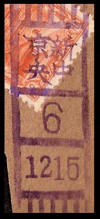  |
Roller cancels from Hsinking Central Post Office. These cancels are found in purple and black. Roller cancels have been in use in Japan from at least the 1920's good, datable copies are very hard to find. The top number is the year date, below this the day date is on the right and the month date is on the left. The first cancel is dated 15th December 1939 and the second 5th February 1940. Roller cancels were often used on parcels, newspapers, wrappers and printed matter. |
|||||||
|
|
Machine cancels such as these have been in use by the Japanese Postal Service since c.1920. The basic wavy line cancel is shown on the right. The Post office is Mukden Central P.O. and it is dated 1st January 1941. Note that the emblem shown at the bottom is a stylized version of the Manchukuo postal emblem while those from the KLT have the "T" shaped symbol of the Japanese Post Office. |
|||||||
|
|
The first item shown here is a machine
slogan postmark from Hsinking Central P.O. dated 1st January
1941. The slogan reads "Be sure to put up a door name-plate" (the little
sketch at top left shows part of an entrance way to a house with a
name-plate affixed). The second slogan comes from Mukden Central P.O. and is dated 5th January 1941. In this instance the slogan can be loosely translated as "With special delivery there is no distance is too far" the aircraft at the top of the cancel is there to imply speed. Most of the slogan cancels that I have seen seem to date to the beginning of 1941, it is possible use was suspended during the war. Both slogans are in Japanese only, again this seems to be the norm. |
|||||||
|
Note - Many more cancels exist than are shown here. Several versions of the Chinese Tri-sected cancels are known. Military and railway versions of the 25mm are missing and will be added when I have examples. Keep checking the website for more information if you are interested in this subject.
|
||||||||
|
|
||||||||
|
SMRZ and Kwantung Leased Territory Cancels |
||||||||
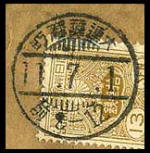 |
This is the standard Japanese 25mm diameter comb style cancel used domestic post. The stamp shown is from the Japanese Tazawa series 13sen. The name of the Post Office in Dairen is shown in the top section. The central date reads 1st July 1936 using the Japanese 昭和 Shōwa era date.
At the bottom is
the cancel time indicates the time the cancel was applied. This is
signified by the use of 前 meaning "before" or a.m,
before noon, normally 8-12 as here, 后 or |
|||||||
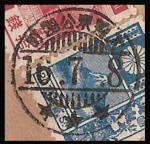 This is another version of the standard Japanese 25mm diameter comb style cancel used for domestic post. In this instance it has been sent from a Railway Office. The central date reads 8th July 1941 |
||||||||
|
This comb style cancel existed well before the formation of Manchukuo and continued in use until 1934 when the I.N.P.O. cancels were introduced. The cancel has a diameter of 23mm to 25mm and the purple colour indicates a rubber stamp was used. The cancel shown comes from a Japanese Post Office in the Moukden (now Shenyang). The date reads from left to right 31st December 1931 three months prior to the founding of Manchukuo. The bottom panel reads I.J.P.O. Imperial Japanese Post Office, these went out of use on 20th April 1934 and were replaced by the I.N.P.O. postmark. The use of these cancels was limited to Japanese foreign-mail exchange offices all of which were controlled by the Japanese postal administration in Dairen. |
||||||||
|
The cancel shown comes from a Japanese Post Office in the capital Hsinking (now Changchun). The date reads from left to right 13th May 1936. The bottom panel reads I.N.P.O. Imperial Nipponese Post Office, this form was introduced on 20th April 1934 and replaced the I.J.P.O. postmark. The use of these cancels was limited to Japanese foreign-mail exchange offices all of which were controlled by the Japanese postal administration in Dairen. |
||||||||
|
|
These are examples of machine cancels. The first was applied at the SMRZ Post Office in Mukden and the second comes from Dairen Central Post Office in the KLT. Both of these cancels are dated 1st January 1934 with the year date "9" being based upon the Japanese 昭和 Shōwa era date. Note that the emblem shown at the bottom is a stylized version of the "T" shaped symbol of the Japanese Post Office set within a blossom.
|
|||||||
|
|
||||||||
|
Dairen PAQUEBOT (Ships Mail) Cancels |
||||||||
|
Paquebot means Ship's Mail, the term is French and is applied throughout member countries of the Universal Postal Union (U.P.U). The rule that covers Ships Mail allows mail posted onboard a ship, while it is outside of territorial waters to be posted (usually handed to the purser) using the stamps of the country under which the ship is registered. The postal rates used are also those of the U.P.U country under which the ship sails. When the ship docks, the purser is able to pass this post to any local Post Office (normally near to, or at the port), in this instance Dairen, where the clerk cancels the mail and applies an additional handstamp "PAQUEBOT". Mail is then processed in the normal way. There is no evidence that Manchukuo had any form of Paquebot cancel, probably because it was not a member of the U.P.U. In any event, most passenger traffic entering the country came in through Dairen. Crew and passengers of ships using the ports of Húlútao and Yingkou would have had to disembark and visit a local post office using local stamps and paying Manchukuoan rates. |
||||||||
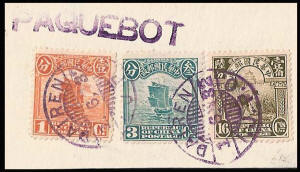 |
This example shows a 25mm standard comb style I.J.P.O. Dairen cancel dated 1st June 1932 with the addition of a Paquebot handstamp. This particular form of handstamp went out of use late in 1934 when I.N.P.O. cancels were introduced. The stamps used are Chinese, indicating that the post came from a Chinese ship.
|
|||||||
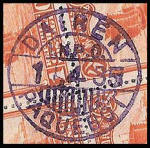 This
shows a standard 25mm comb style Dairen cancel dated 1st May 1935
with the letters I.N.P.O. included in the top middle segment. The
word Paquebot appears in the bottom segment. This
shows a standard 25mm comb style Dairen cancel dated 1st May 1935
with the letters I.N.P.O. included in the top middle segment. The
word Paquebot appears in the bottom segment.
As can be seen in the image below, not all Post Offices or agencies in Dairen seem to have had access to the this cancel and as with the I.J.P.O. example shown above relied upon an ordinary "Paquebot" hand stamp.
|
||||||||
|
The cover above is courtesy of Mr Richard Arent. |
||||||||
 Partial example of a Dairen "PAQUEBOT" roller cancel. These are hard to find and only being a partial image it is hard to date but this example is likely to be from the mid to late 1930's. |
||||||||
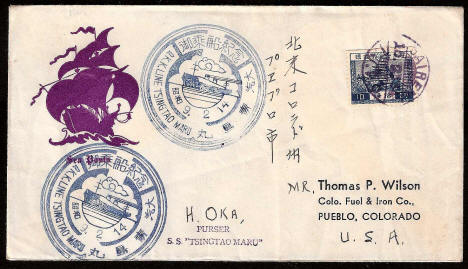 |
||||||||
|
The Sea Posts cover shown above does not carry a "Paquebot" handstamp but it is clear that this post originated from a ship. The reason is probably that the stamps and postal rates in Dairen were the same as those in Japan, making any special treatment unnecessary. This is a cover cancelled upon the steamship Tsingtao Maru on 14th February 1934 and posted in Dairen on 15th February 1934. The dating system on the ship's cancel is Japanese, the 9 being the ninth year of the era Showa). There is no arrival date-stamp. The Tsingtao Maru was owned by the DKK (Dairen Kisen Kaisha) line and sunk by American aircraft in 1944. |
||||||||
|
Issued 6th August
1938. The dating based upon
the Japanese
昭和
Shōwa era.
Size 48mm dia. Known
colours - violet |
||||||||
|
|
||||||||
| A Small Selection of Postal Markings | ||||||||
 |
 |
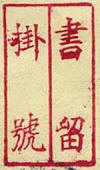 |
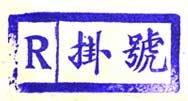 |
|||||
| Registered - Japanese 書留 Kaki tome (Yuban) | Registered | Registered in Chinese 掛號 Guàhào | ||||||
 |
 |
 |
 |
|||||
| To Switzerland Handstamps - Common due to the number of missionary covers coming from Manchukuo. | ||||||||
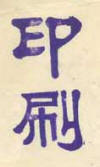
 |
 |
|||||||
| Printed Matter handstamps, "Printed" being 印刷, an extra character can be added 品 (matter) | Harbin Central Avenue P.O. 哈爾濱中央大街郵政局 Registration Hand-stamp. (Note: This is not Harbin Central 哈爾濱中央) | |||||||
|
|
|
|||||||
|
航空 Air Mail Hand-stamp |
Express Hand-stamp |
|||||||
|
|
||||||||

